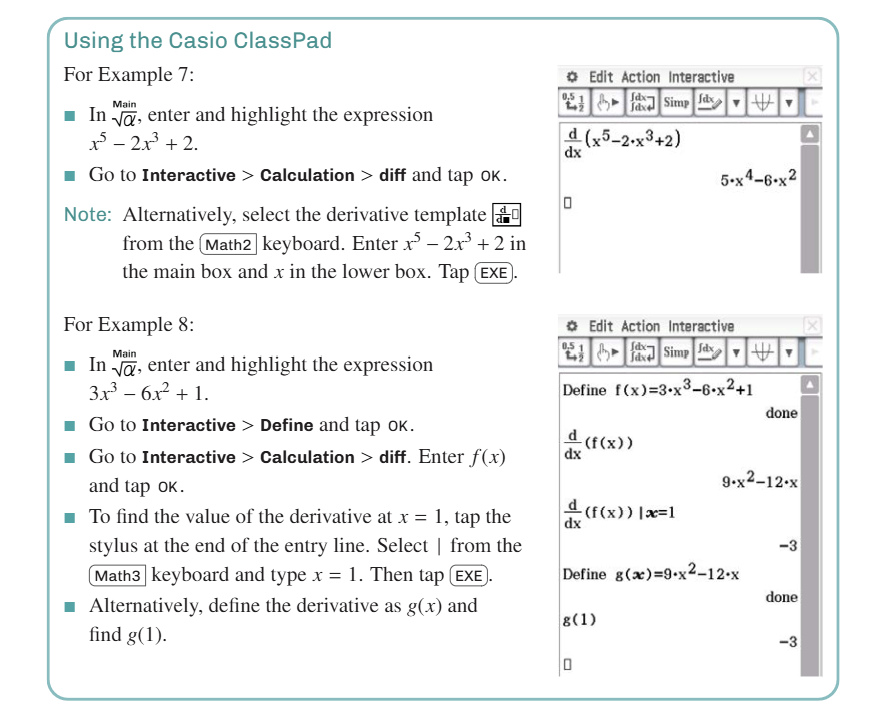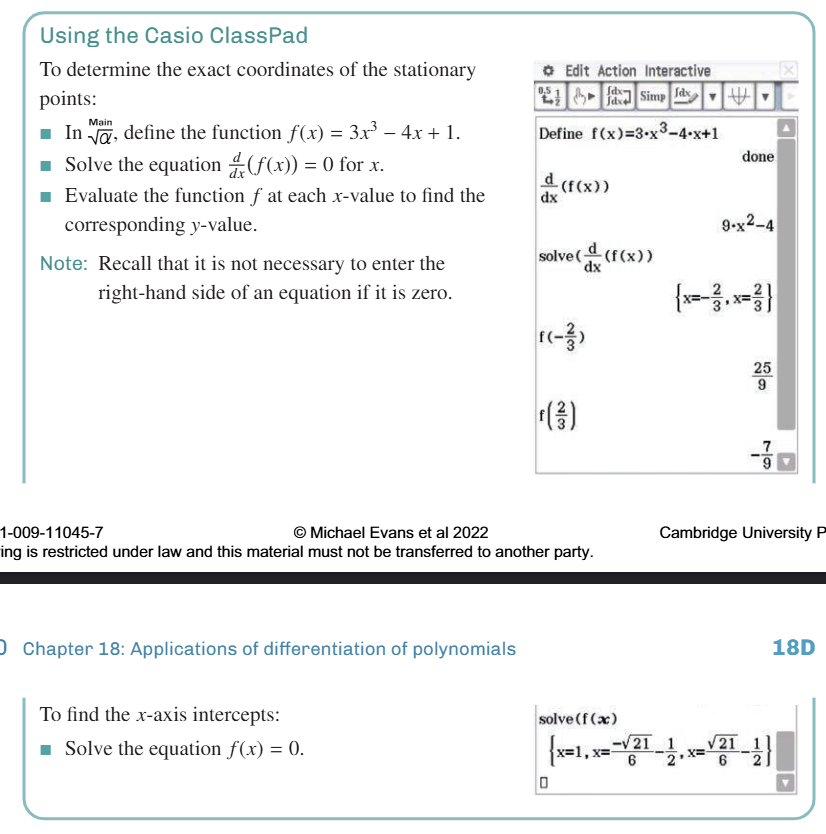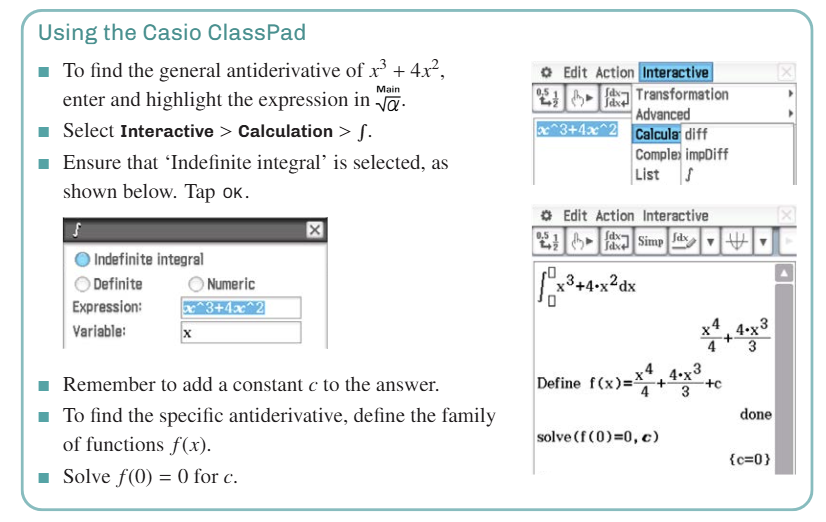Methods: Chapter 18-21 - Calculus
1/27
Earn XP
Description and Tags
Smash that calculus!
Name | Mastery | Learn | Test | Matching | Spaced |
|---|
No study sessions yet.
28 Terms
Average Rate of Change
Measures how much a function changes on average over an interval
Formula: \frac{f(b) - f(a)}{b - a}
It's the gradient of the secant line through (a, f(a)) and (b, f(b))
For motion, it's average speed = distance ÷ time
The Derivative
Key Concepts
A secant is a line through two points on a curve.
A tangent is a line that touches the curve at one point with the same gradient.
The instantaneous rate of change is the gradient of the tangent.
First Principles Definition
Derivative: Slope
f'(x) = \lim_{h \to 0} \frac{f(x+h) - f(x)}{h}
Approximating Derivatives
For small h:
f'(a) \approx \frac{f(a+h) - f(a)}{h}
Tangents
Gradient of tangent at x = a:
👉 f'(a)
So at point (1, −2), if f'(1) = −3, the tangent’s slope = -3.
Notes
Derivative exists only if the limit exists.
All polynomials are differentiable.

Derivative Rule - Basic
Power Rule
If f(x) = xⁿ, then
👉 f'(x) = n xⁿ⁻¹
(Proven using the binomial theorem.)
Special Cases
Constant:
f(x) = c ⇒ f'(x) = 0Linear:
f(x) = mx + c ⇒ f'(x) = m
Add-Ons
Multiply:
f(x) = k ⋅ g(x) ⇒ f'(x) = k ⋅ g'(x)Sum:
f = g + h ⇒ f' = g' + h'Difference:
f = g − h ⇒ f' = g' − h'
🧪 Examples
f(x) = x⁵ − 2x³ + 2
👉 f'(x) = 5x⁴ − 6x²
f(x) = 3x³ − 6x² + 1
👉 f'(x) = 9x² − 12x, so f'(1) = −3

Lebiniz Notation
If y = x³, write:
👉 dy/dx = 3x²
(Same idea, different style. Don't treat dy/dx like a fraction.)
Differentiating xⁿ where n is a negative integer
Power rule still applies: derivative of xⁿ is nxn-1
Domain: x ≠ 0 (no zero allowed because of division)
Examples:
• d/dx (1/x) = -1/x²
• d/dx (x⁻³) = -3x⁻⁴Constants → derivative is 0
Tangent slope = derivative evaluated at point
Negative powers = fractional forms, watch domain carefully!
Differentiating rational powers (x to the p over q)
Use first principles for simple powers like x¹ᐟ², x¹ᐟ³
Key identity: aⁿ - bⁿ = (a - b)(aⁿ⁻¹ + aⁿ⁻²b + … + bⁿ⁻¹)
Use chain rule for general rational powers:
y = x^{\frac{p}{q}} = \left(x^{\frac{1}{q}}\right)^p \quad \Rightarrow \quad \frac{dy}{dx} = \frac{p}{q} x^{\frac{p}{q} - 1}Domain: x > 0 (to avoid issues with roots of negatives)
Applies to any real non-zero power: derivative of xᵃ is a × xᵃ⁻¹
Examples:
\frac{d}{dx} \left( x^{\frac{2}{3}} \right) = \frac{2}{3} x^{-\frac{1}{3}}\frac{d}{dx} \left( 4x^{\frac{2}{3}} \right) = 4 \times \frac{2}{3} x^{-\frac{1}{3}}
Graphs of fractional powers are smooth for x > 0 but tricky near 0 for some powers
Chain Rule
The chain rule is like mom(son) — a function inside a function.
To differentiate y = mom(son), do: derivative = son' × mom'(son).
Break y = f(g(x)) into:
Son = g(x) (inner function)
Mom = f(u) (outer function, with u = son)
Steps:
Differentiate inner: son' = g'(x)
Differentiate outer at son: mom'(son) = f'(u) at u = g(x)
Multiply: dy/dx = mom'(son) × son'
Example: y = (3x + 4)^20
son = 3x + 4, son' = 3
mom = u^20, mom' = 20u^19
\frac{dy}{dx} = 20(3x + 4)^{19} \times 3 = 60(3x + 4)^{19}
Official formulas:
Chain rule (function notation):
(f\circ g)^{\prime}(x)=f^{\prime}(g(x))\times g^{\prime}(x),\text{ where }(f\circ g)(x)=f(g(x)) Chain rule (Leibniz notation):
\frac{dy}{dx} = \frac{dy}{du} \times \frac{du}{dx}
Tangents & Normal
Derivative gives the gradient of the tangent at any point on a curve.
Tangent line equation at (x₁, y₁):
y − y₁ = f'(x₁)(x − x₁)Normal line is perpendicular to the tangent.
If tangent gradient = m, normal gradient = −1/m
Example tangent:
For y = x³ + ½x² at x = 1:
Point: (1, 3/2)
Gradient: f'(1) = 4
Tangent: y − 3/2 = 4(x − 1) → y = 4x − 5/2
Example normal:
For y = x³ − 2x² at (1, −1):
Tangent gradient: f'(1) = −1
Normal gradient: 1
Normal: y + 1 = 1(x − 1) → y = x − 2

Stationary Points
A point (a, f(a)) on curve y = f(x) is stationary if the derivative = 0 at x = a.
In symbols: f'(a) = 0 or dy/dx = 0 at x = a.
At stationary points, the tangent is horizontal (parallel to x-axis).
Types:
Local Maximum: f′(x) changes from + to – (peak)
Local Minimum: f′(x) changes from – to + (valley)
Inflection Point: f′(x)=0, no sign change (flat but no turn)
Turning Points: Local max and min only.
Examples:
y = 9 + 12x − 2x²
dy/dx = 12 − 4x
Set to 0: 12 − 4x = 0 → x = 3
Stationary point: (3, 27)

Steps to solve max/min problems
Draw & label diagram; define variables and limits.
Express quantity to max/min as a single-variable function.
Find stationary points where derivative = 0.
Test points to identify local max/min/neither.
Check function values at domain endpoints if any.
Second Derivative
The derivative of the first derivative:
f″(x) = d/dx (f′(x))
Example:
If f(x) = 2x² + 4x + 1, then f′(x) = 4x + 4 and f″(x) = 4
In physics:
position = x(t), velocity = dx/dt, acceleration = d²x/dt²
Example:
f(x) = 3x³ + 2x⁻¹ + 1
f′(x) = 9x² − 2x⁻²
f″(x) = 18x + 4x⁻³
Second Derivative Test
If f ''(x) > 0, the function is concave up ⇒ local minimum
If f ''(x) < 0, the function is concave down ⇒ local maximum
If f ''(x) = 0, the test is inconclusive
Use it at critical points where f '(x) = 0
Sketching Graphs
Steps for sketching graphs:
Find x-axis and y-axis intercepts and stationary points.
Identify where the graph is increasing and decreasing.
Determine the nature of each stationary point:
• local maximum
• local minimum
• stationary point of inflectionIdentify vertical asymptotes.
Understand the behavior as x \to +\infty \quad \text{and} \quad x \to -\infty
Graphs of the derivative function
Sign of derivative tells slope direction of original graph:
If f′(x) > 0, graph slopes up (increasing).
If f′(x) < 0, graph slopes down (decreasing).
If f′(x) = 0, potential stationary point.
Intervals:
Increasing where f′(x) > 0.
Decreasing where f′(x) < 0.
Stationary points where f′(x) = 0.
Derivative tests:
f′(x) > 0 → function strictly increasing on interval.
f′(x) < 0 → function strictly decreasing on interval.
But watch out: strictly increasing doesn’t always mean f′(x) > 0 everywhere (like f(x) = x³).
Gradient & angle connection:
Gradient m = tan(θ), where θ is angle with x-axis.
E.g., θ=45° means m=1; θ=135° means m=−1.
Use derivative to find tangents at given slopes or angles.
CAS: Plot graph of normal function and derivative function.
Families of Functions and Transformations
Given f(x) = (x − a)2(x − b), with a, b positive and b > a:
a) Derivative: f'(x) = (x − a)(3x − a − 2b) (found using CAS)
b) Stationary points: (a, 0) and ( (a + 2b)/3 , value from f(x) )
c) Local max at (a, 0) because f'(x) changes from positive to negative around a
d) Given stationary points at x=3 and x=4, then:
a = 3
(a + 2b)/3 = 4 → b = 9/2
Limits and Continuity
Limit Definition
Limit (lim): As x approaches a, f(x) gets arbitrarily close to L. Written as \lim_{x\to a}f(x)=L .
For many functions (especially polynomials), \lim_{x \to a} f(x) = f(a)
If f is not defined at a, factor or simplify to find the limit.
Algebra of Limits (if limits exist):
\lim_{x \to a} [f(x) + g(x)] = \lim_{x \to a} f(x) + \lim_{x \to a} g(x)
\lim_{x \to a} [k f(x)] = k \lim_{x \to a} f(x)
\lim_{x \to a} [f(x) g(x)] = \lim_{x \to a} f(x) \times \lim_{x \to a} g(x)
\lim_{x \to a} \frac{f(x)}{g(x)} = \frac{\lim_{x \to a} f(x)}{\lim_{x \to a} g(x)}, \quad \text{if } \lim_{x \to a} g(x) \neq 0
Left and Right Limits:
\lim_{x \to a^-} f(x) \quad \text{is the limit approaching from the left}
\lim_{x \to a^+} f(x) \quad \text{is the limit approaching from the right}
Limit exists only if both are equal.
Continuity at x = a:
f is continuous at a if:
f(a) is defined, and
\lim_{x \to a} f(x) = f(a)
Otherwise, f is discontinuous at a.
Note:
Polynomials are continuous everywhere.
When is a function differentiable?
When is a function differentiable?
A function f is differentiable at x = a if the f'(a) = \lim_{h \to 0} \frac{f(a+h) - f(a)}{h} exists.
Polynomials are differentiable everywhere (for all real numbers).
Example: Modulus function
f(x) = x if x ≥ 0; f(x) = -x if x < 0
Gradient of secant between (0,0) and (h, f(h)) is:
1 if h > 0
-1 if h < 0
Left and right limits do not match → derivative does not exist at 0
So, f is not differentiable at x = 0.
Derivative function for modulus
f'(x) = 1 if x > 0
f'(x) = -1 if x < 0
Piecewise differentiability and smooth joins
Some piecewise functions are differentiable everywhere if their joins are smooth.
Example 1
f(x) = x² + 2x + 1 if x ≥ 0; f(x) = 2x + 1 if x < 0
Derivative: f'(x) = 2x + 2 if x ≥ 0; f'(x) = 2 if x < 0
f'(0) exists and equals 2 → smooth join → differentiable at 0
Example 2
f(x) = x² + 2x + 1 if x ≥ 0; f(x) = x + 1 if x < 0
Derivative: f'(x) = 2x + 2 if x > 0; f'(x) = 1 if x < 0
f'(0) does not exist (left and right limits differ)
Differentiable everywhere except at 0
Difference of Join and Join Smoothly
Join: Use limit to check if functions meet (values equal at a point)
Join smoothly: Use first derivative limit to check if slopes match (derivatives equal at that point)
Antidifferentiation of Polynomials
Antidifferentiation: Finding a function from its derivative.
Functions with the same derivative differ by a constant (vertical shifts).
Rules:
\text{If } F'(x) = f(x), \quad \int f(x) \, dx = F(x) + c(differentiation lose components; any constant).
Reverse power rule:
\int x^n \, dx = \frac{x^{n+1}}{n+1} + c, \quad n \neq -1
Linearity:
\int [f(x) + g(x)] \, dx = \int f(x) \, dx + \int g(x) \, dx
\int [f(x) - g(x)] \, dx = \int f(x) \, dx - \int g(x) \, dx
\int k f(x) \, dx = k \int f(x) \, dx
Finding specific antiderivatives (with initial conditions):
Use general f(x) = \int f'(x) \, dx + c
Plug known point to solve for c
Example:\text{ If }f^{\prime}(x)=x^3+4x^2,f(0)=0:\quad f(x)=\frac{x^4}{4}+\frac{4x^3}{3}+c
Examples:
\text{Example: }\int3x^5\,dx=\frac{1}{2}x^6+c
\int (3x^2 + 4x^3 + 3) \, dx = x^3 + x^4 + 3x + c
Antidifferentiating rational powers
\int x^r dx = \frac{x^{r+1}}{r+1} + C \quad (r \neq -1)
r must be a rational number, not -1
Domain of x depends on the value of r
\int (2x - 4 + 6x) dx = 4x^2 - 4x + C
Finding the Exact Area: The Definite Integral
It gives the exact area under a curve:
\int_a^b f(x)\,dx = [F(x)]_a^b = F(b) - F(a)F is any antiderivative of f (thanks to the Fundamental Theorem of Calculus)
It’s the limit of Riemann sums as n → ∞
Works when f is continuous on [a, b]
This is called the definite integral of f(x) with respect to x from x = a to x = b.
This is called the fundamental theorem of calculus (cool!).
Extended, complex version of definite integral
The definite integral ∫ₐᵇ f(x) dx is the limit of a sum:
\int_a^b f(x)\,dx = \lim_{n \to \infty} \sum_{i=1}^n f(x_i^*) \frac{b - a}{n}
xᵢ* is a sample point in the i-th subinterval
This sum approximates area under f(x); the limit gives the exact value
Extension: Universal Rule for \int(ax+b)^{n}dx
\int (ax + b)^n dx = \frac{(ax + b)^{n+1}}{a (n+1)} + C
Signed area vs Total area
• Signed area = \int_a^b f(x) \, dx → positive above x-axis, negative below
\text{Total area} = \int_a^b |f(x)| \, dx → all areas positive
• If f(x) ≥ 0 on [a, b]: Area =\int_a^b f(x) \, dx
• If f(x) ≤ 0 on [a, b]: Area = -\int_{a}^{b}f(x)\,dx
• If f(x) changes sign at x = c (a < c < b):
\text{Area} = -\int_a^c f(x) \, dx + \int_c^b f(x) \, dx
\text{Total area} = \int_a^b |f(x)| \, dx
• Geometry tricks:
– Triangle: ½ × base × height
– Trapezium: ½ × (a + b) × height
Properties:
\int_a^b f(x) \, dx = -\int_b^a f(x) \, dx
\int_a^a f(x) \, dx = 0
\int_a^b k \cdot f(x) \, dx = k \cdot \int_a^b f(x) \, dx
\int_a^b [f(x) \pm g(x)] \, dx = \int_a^b f(x) \, dx \pm \int_a^b g(x) \, dx
\int_a^b f(x) \, dx = \int_a^c f(x) \, dx + \int_c^b f(x) \, dx
Tips:
🧠 Use the split rule when the function changes sign or form mid-way.
Insert Integral on CAS

Estimating Area
Divide the interval [a, b] on the x-axis into n equal subintervals [x₀, x₁], [x₁, x₂], [x₂, x₃], …, [xₙ₋₁, xₙ] as illustrated.
Estimates for the area under the graph of y = f(x) between x = a and x = b:
Left-endpoint estimate
L_n = \frac{b - a}{n} \times \left[ f(x_0) + f(x_1) + \cdots + f(x_{n-1}) \right]
Right-endpoint estimate
R_n = \frac{b - a}{n} \times \left[ f(x_1) + f(x_2) + \cdots + f(x_n) \right]
Trapezoidal estimate
T_n = \frac{b - a}{2n} \times \left[ f(x_0) + 2f(x_1) + 2f(x_2) + \cdots + 2f(x_{n-1}) + f(x_n) \right] These methods work for any continuous function on [a, b], regardless of whether the graph is increasing or decreasing.
SAC/Exam Tips 1:
For f: \mathbb{R} \setminus \{0\} \to \mathbb{R}, \quad f(x) = x^{-3} , what must you show?
Differentiate: f'(x) = -3x⁻⁴. For x > 0, x⁻⁴ is always positive, so f'(x) is always negative. The derivative is valid for all x ≠ 0 and always holds for positive x.
SAC/Exam Tips 2:
What MUST you do first when differentiating in a sac/exam?
\text{Declare } y = \ldots \text{ before } \frac{dy}{dx}
\text{Example: } y = x^3 + 2x \implies \frac{dy}{dx} = 3x^2 + 2